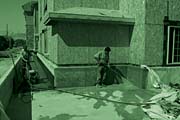Green Rooftops Need Reliable Waterproofing

Commonplace in European countries such as Germany, and gaining popularity in major U.S. cities, green roofs have expanded construction opportunities to other areas of the country. They are being used more frequently because of their long-term integrity and their ability to minimize storm water drainage and the effects of urban heat islands.
Arid climates such as Utah experience the overwhelming temperatures of desert heat exposing the roof to tremendous thermal shifts. Green roofing offers stability for the roof against drastic temperature changes.
To take full advantage of green roof benefits, the system must be constructed properly. Although green roofs have only existed in the United States for about a decade and expertise with green roof applications is sometimes hard to find, one thing remains understood: waterproofing is the most important and critical element of the system.
One of the new projects in Utah that has specified green roof systems is the Newport Village project in Orem, Utah. The Newport Village project is a six-building community of luxury condominiums that is being built by Adamson Construction. "The city of Orem requires a certain amount of area to be landscaped," says Kaye Adamson, president of Adamson Construction, a general contractor in Orem, Utah. "The green roof will add a great touch to the complex."
With the groundbreaking in September of 2003, the small community of condos was completed in October 2004. The three-story condos will overlook multiple surrounding planters, as well as a large green roof on the one-level below-grade parking deck.
Scott Hansen and Kirk Williamson, owners of Newport Village condominiums, designed the green roof system for the 90-unit community of condos to help manage storm water and give residents an aesthetically pleasing view. "We didn't want to place sod around the condos," says Hansen. "We wanted a system that would drain efficiently and look great. I wanted to use green roofs to solve water issues and control the immediate environment."
With a green roof specified, it was crucial to find an experienced and reliable waterproofing contractor. "There are only a few waterproofing contractors in the state that apply elastomeric waterproofing systems," says Dan Barker, a representative of Division 7 Specialties in Ogden, Utah.
"My crew has been working on nearly all of the aspects of this job except for the waterproofing," says Adamson. For this reason, the general contractor of the project requested assistance from a company with extensive experience in waterproofing.
The company chosen for the waterproofing was Warburton's Inc., a waterproofing contractor in Orem, Utah, and the waterproofing products of choice were from Carlisle Coatings and Waterproofing, Wylie, Texas. "I personally have 22 years of experience with waterproofing," says Jeff Gallup, project manager for Warburton's. "We opted for a system that is easy and safe to apply." He explains that while both hot- and cold-applied membranes work exceptionally well on green roof systems, the cold-applied is a safer, easier alternative because of its application. "If you use a cold-applied system, there is no need for a hot mop or specialized equipment."
Warburton selected CCW's 525 cold-applied membrane for the project. The product reduces the threat of injury through its application method, and ensures long-term integrity, a necessity for any roof or planter.
"Every waterproofing step is important to the integrity of the overall system," states Gallup. "Prior to the application of the waterproofing membrane, voids and transitions were filled with a single-component polyurethane caulk. Any cracks that were larger than 1/16 of an inch were grinded and filled with caulk. We are very precise about the preparation."
Once all imperfections were filled, the entire deck was cleaned with a pressure washer. The CCW-525 60-mil membrane was applied with a 1/4-inch notched squeegee on the horizontal concrete substrate and with a roller on the vertical substrate. The vertical substrate was applied with two 30-mil coats and the horizontal with one 60-mil coat.
A liquid-applied, single-component elastomeric membrane, CCW-525 prevents water migration in both of these areas. "It's easy to work with," says Leonel Alvarado of Warburton. "It's very fast to apply and it only has to cure for about a day."
About 36 hours after the membrane is applied, it is fully cured, and drain detailing can begin. "We completely covered the drains throughout the roof with the cold-applied membrane and then after it cured we cut around the drains," said Gallup. "This ensures that the drain is completely sealed around the perimeter. Again, every little detail matters."
Over 72 hours after the application of the membrane, flood testing is recommended. "Something can always happen at a jobsite, but you feel safe as a contractor when the products used are supported by a reputable company. We chose this system because of the strength of Carlisle Coatings and Waterproofing," said Gallup. The testing was successful with 2 inches of water remaining inside the planters for at least 24 hours. This ensures the quality of the applied membrane.
Following the testing of the monolithic membrane, CCW's MiraDRAIN 9800 drainage composite was rolled over the cured membrane. Because of this green roof's shallow depth, there was no need for a root barrier layer in the system. "This system works well because it keeps water from migrating to the concrete," said Hansen. "Parking decks are vulnerable to cracks in the concrete from water damage."
Once the basic layers of the green roof were installed, a landscape crew installed the final vegetated top layer. "We used a series of indigenous plants and native grasses in the planters and green roof," says Brett Burr, president of Yardworx, a landscape company in Provo, Utah. "Because of the high temperatures Utah is exposed to, we selected water-wise plants or plants that do not require a lot of water, for this drip irrigated system."
This drip system involves the installation of tiny emitters next to each plant base. Unlike typical irrigation systems that emit a large broadcast of water throughout the green roof, a time-regulated water drip system provides a more economical method of saturating green roof vegetation.
With all elements of a green roof working together, it essentially boils down to the waterproofing. Waterproofing is a proactive and preventative element of the green roof system that both protects and enhances long-term performance. Although green roof systems are relatively new, proper waterproofing can help ensure the long-term success of these projects.
Looking for a reprint of this article?
From high-res PDFs to custom plaques, order your copy today!




